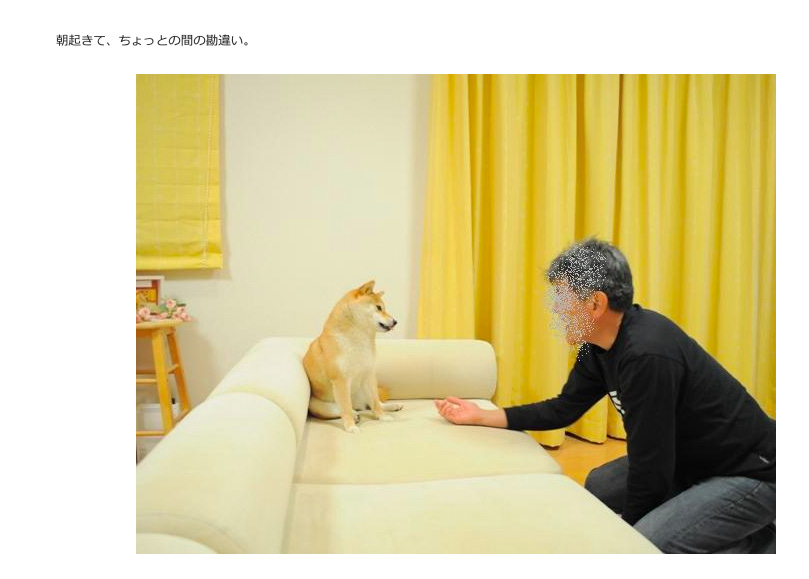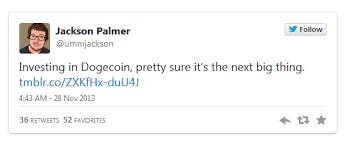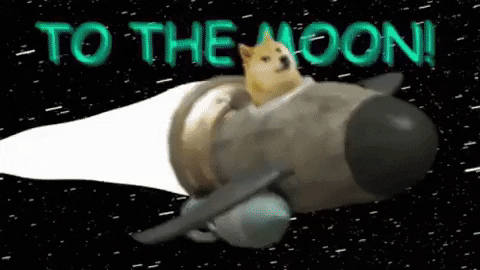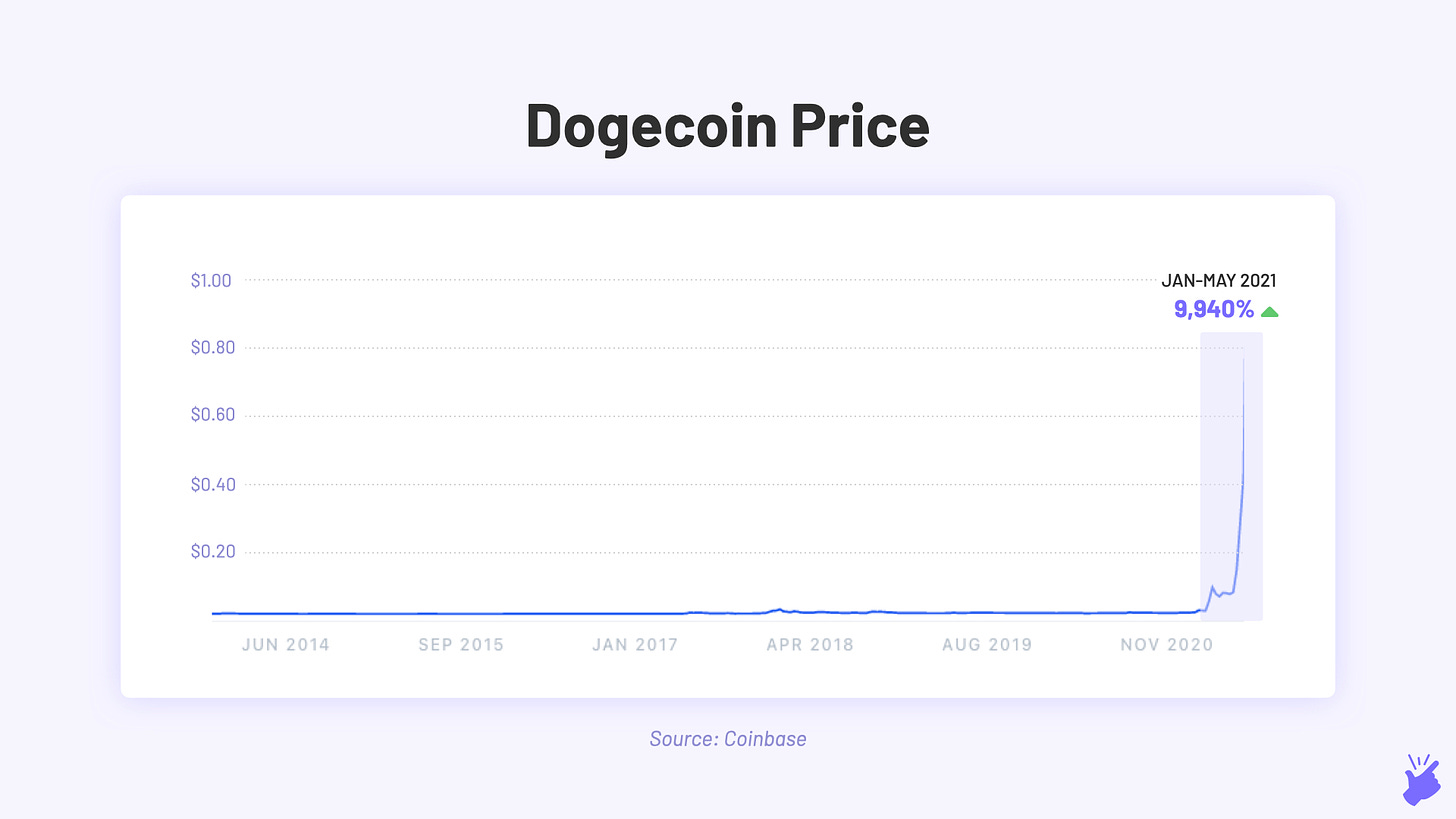7,700+ curious folks read Simplanations. Join them by signing up here:
This is the story of Dogecoin - an internet joke that became a reality. If you think Trump becoming the US president was a joke that went too far, you haven't heard Dogecoin's story. Multiple new trends in the internet economy built upon each other to make this joke become worth $85 billion at its peak this year. So here's the story of Dogecoin in 3 chapters - each chapter for a trend that helped make Doge what it is today.
Chapter 1: Memes
In 2008, a puppy mill (a place where dogs are bred) in Japan shut down abandoning 19 pups. All the 19 belonged to one breed, the Shiba Inu - a hunting dog breed that originated in Japan 3000 years ago. These pups were rescued by an animal shelter shortly and the kind volunteers began naming the pups. One of the Shiba Inus, a female one was named Kabosu, after a Japanese citrus fruit because her face was round like the fruit. Sometime later, Kabosu was adopted by a kindergarten teacher Atsuko Sato. Sato liked the name Kabuso and kept it. Kabuso, as Sato would narrate later, loved being photographed. It was perfect because Sato ran a blog where she posted pictures of dogs to raise awareness about the dangers of puppy mills. Kabuso began to feature regularly on Sato's blog and soon found an audience. On Feb 23rd 2010, in a turn of events Sato could never have imagined, she would post a set of Kabuso's photos on her blog that would blow up 1000s of miles away in the United States. Not immediately but years later.
In parallel to Sato's adventures with Kabuso, two other things were happening.
One: In October 2010, a Reddit user would post a funny image corgi breed dog titled "LMBO LOOK @ THIS FUKKIN DOGE" kickstarting the phenomenon of using "doge", a misspelling of dog, for silly images of dogs shared on the internet.
Two: In September 2012, a Tumblr blog named "Shiba Confessions" would launch. The only purpose of the website was to share funny pictures of Shiba Inu dogs with multi-coloured text on them in Comic Sans font style.
There is no specific date or event as to when these three things - Kabuso, doge and Shiba confessions - collided. But they did and sometime in early 2013, online searches for the "doge meme" began to rise. The meme, as we all now know, was Kabuso's face with rainbow-coloured comic sans text on it, usually two-word phrases like "such wow" and "much respect". It shot into the mainstream limelight in late 2013 when it was picked as the year's top meme by Know Your Meme and also picked up by MTV in its list "50 Things Pop Culture Had Us Giving Thanks For".
Doge, the meme, had arrived. But this was only the beginning.
Chapter 2: Money
In January 2009, bitcoin was launched by the still anonymous Satoshi Nakamoto kickstarting the concept of "cryptocurrencies" - a form of digital money that operated on the principle of decentralization.
A quick, over-simplified explanation of what centralized and decentralized money means.
The currency we use today (rupee or dollar) is controlled by one entity, the central bank (RBI in India) - hence centralized. The central bank decides how much money to print and what the value of a note is, ie, a ₹10 is worth ₹10 because the central bank says so. In the case of cryptocurrencies, there is no central body that controls them. Each cryptocurrency is governed by a set of rules ("protocols") that are made before the currency comes into existence. This set of rules decide how many units (coins in the case of Bitcoin) can come into existence each year and how they can be created. Anyone can create the currency if they follow those set of rules - hence decentralized. The value of the currency is decided by the collective market, ie, buyer and sellers.
The idea of decentralized money caught on. And given that the protocols of Bitcoins were open-sourced computer code, anyone with decent programming knowledge could launch their own cryptocurrency. So quite a few people, geniuses as well as fraudsters, began to launch their own coins (few legit currencies that were launched at that time include Ethereum, Ripple & Litecoin). These cryptocurrencies were mostly variations of how bitcoin operated - the founders either tweaked the rules around how many coins could be created or how they could be created. Few like Ethereum were a bit more different and involved genuine innovation (but we won't go into the details here). These alternatives to bitcoin were called altcoins.
By 2013, there were more than 60+ altcoins in existence and "cryptocurrency" was a buzzword slowly finding its way into mainstream media. If you remember from Chapter 1, 2013 was the also year the doge meme was blowing up on the internet.
By the way, there are more than 4,000 cryptocurrencies in existence today.
On 28th Nov 2013, after observing both the trends rise simultaneously, Jackson Palmer, an executive working with Adobe joked on Twitter "Investing in Dogecoin, pretty sure it's the next big thing".
Palmer was just joking and had no intentions of creating a cryptocurrency like that. But the tweet got a lot of attention. Just for laughs, Palmer went on to buy the Dogecoin.com domain and put up a picture of a coin with the doge meme on it. He also added a note on the site: If you want to make Dogecoin a reality, get in touch.
Bill Markus, an engineer at IBM, came across Palmer's Dogecoin website and found the idea funny. Bill already had some experience building cryptocurrencies. He had created one called "Bells" as a fun side project but it never took off. He decided to get in touch with Palmer.
Making Dogecoin a reality
As per Bill's recount later, it took him just 3 hours to develop Dogecoin. All he did was tweak the open-source code of another altcoin called 'Litecoin" which itself was a variation of the code of Bitcoin.
Bitcoin had a limit of 21 million coins that could ever come into existence. And only a fraction of these coins would be made available every year through a process called "mining". Billy made more than 100 billion dogecoins available for mining at the time of release. He also added a rule that 5 billion new dogecoins would be made available for mining every year for perpetuity. Finally, keeping up the spirit of Doge, Billy also changed the word 'mine' to 'dig' and the font to the one used in the Doge memes.
Explaining mining in detail will take an entire post. For now, think of "mining" as the process by which a really advanced computer runs some bits of complex code to bring more coins of a cryptocurrency into existence.
Now anyone serious about launching their own cryptocurrency mines a decent number of coins for themselves before making a public launch. This activity is called pre-mining. For instance, it is believed that almost 72 million Ethereum coins (60% of the total supply available) were pre-mined before its launch. In the case of Dogecoin, since the creators were doing it as a joke and never expected any financial returns, they pre-mined only 10,000 dogecoins for themselves. After this small pre-mining exercise, the coin was made live on the website in December 2013.
Adoption of Dogecoin
To Palmer and Bill's surprise, dogecoin took off. Within just 30 days of launch, there were over a million visitors to the website. Reddit turned out to be the origin for a majority of the visitors. A dogecoin subreddit had cropped up and was buzzing with users helping each other mine and transact dogecoins.
The price of dogecoin around this time was close to $0.0008, almost negligible. Given such a low value, you would expect it didn't really mean much to people. However, Redditors had created an interesting way to use dogecoins - a Reddit tipping bot. A Reddit user could use the bot to tip a fellow Redditor as a token of gratitude for their contribution to the discussions on the platform. It turned out, the currency being a joke was what made it more attractive. Dogecoin felt more accessible and likeable to users. And they felt gifting these coins was a cool way to show appreciation for others.
In a further boost to this friendly image, Dogecoin began to be used to support noble causes. For example, in Jan 2014, the Dogecoin community raised more than $36,000 for the Jamaican team which had qualified for, but could not afford to go to, the Sochi Winter Olympics. In another cause, the community raised $30,000 (40 million dogecoins) to help Kenya which was struggling with a water crisis. Members tipped towards the cause through the Reddit tipping bots.
The tipping bot and fundraisers were major drivers in increasing the number and value of dogecoins trading. Soon, other major community platforms like Twitter, Slack and Discord added a tipping bot. This further increased the number of dogecoins in circulation. In 2014, the trading volume of 1-year-old Doge surpassed Bitcoin and all other cryptocurrencies combined.
Doge, the currency, had arrived. But even Dogecoin's users had no idea about the storm that was coming.
Chapter 3: Moon
Post-2014, Dogecoin's price crawled over the next 6 years, very slowing 10x-ing from $0.0002 to $0.0020, but still at negligible levels. However, towards the latter half of 2020, few interesting incidents began to happen.
In July 2020, a trend started on Tik Tok became where influencers started asking viewers to invest in Dogecoin and take its value to $1. And no prizes for guessing - viewers actually listened. Dogecoin price doubled and crossed the $0.0040 mark. The "Doge at $1" vision caught on and internet forums, mainly the Dogecoin and WallStreetBets subreddits, were soon abuzz with discussion about how to achieve the $1 price.
The biggest push however came in the form of Elon Musk. In a series of tweets that started in Dec 2020 and are still going on, Musk began to hype Dogecoin as the future currency of the earth. As Musk tweeted, people thronged to buy dogecoin sending the prices soaring. He called himself the "DogeFather". The price went further up. He changed his bio to "The CEO of Dogecoin" and more people thronged to buy.
His tweet about taking "Dogecoin to the mooooooon" soon became the war-cry for the community. Fans made songs, GIFs, memes about dogecoin to the moon! People even coded bots to buy Dogecoin when Musk tweeted about it.
Other celebrities joined in on the fun. Singer Snoop Dogg tweeted about Dogecoin. Mark Cuban, the owner of the NBA team Dallas Mavericks, got his NBA team to start accepting dogecoins as payments for tickets and merchandise sales.
This whole frenzy resulted in Dogecoin rising 9,940% this year (Jan - May 2021) and touching the peak price of $0.73 in the first week of May. Its market capitalization (no. of coin x price of coins) increased from $1 billion in January 2021 to touch a peak of $85 billion.
The craze was so much that the platforms that enabled crypto trading - Robinhood, the leading discount broker from the US and WazirX, India's largest crypto exchange both crashed that week unable to keep up with the traffic and trading volumes.
The frenzy culminated with a 40% crash in prices (down to $0.45) on May 8th when Musk appeared on the comedy show "Saturday Night Live" (SNL). During the show, Musk agreed with the show's host that Dogecoin was a hustle immediately leading to a slide in prices. But Musk tried making it up to the community the next day by announcing that SpaceX is literally going to put a dogecoin on the moon, with the mission too being funded by dogecoins. The move seems to be working for now as it has arrested the slide in price. At the time of writing this piece, the price was hovering around $0.5.
Epilogue: Dogecoin's future
Will dogecoin exist in the future? We don't know. Will its price go up further? Honestly, we don't know. There is certainly no saying where Musk and the Doge fans are going to take Dogecoin to. At least going by the recent history.
What we do know for certain is that Dogecoin, going forward, will face a problem of abundance. Let us explain.
As mentioned earlier, Dogecoin's supply was around 100 billion coins when it launched in 2014 (late Dec 2013 to be exact). And 5 billion coins are added to the supply every year, ie, around 10,000 new coins every minute. As of now, there are more than 128 billion dogecoins in circulation and increasing by the minute. In comparison, Bitcoin has only 18.7 million coins in circulation. And it will never cross 21 million coins - because that's the rule with which it was created.
Using the simple concept of supply and demand, we know that the unlimited and ever-increasing supply of dogecoins will ensure its price remains low. Now, why does this matter?
A cryptocurrency at the end of the day is money. And money has 2 functions - store of value (investment) and medium of exchange (payment). In simpler words, I can either use my money to buy some asset that can give me some return and ensures my money's value doesn't reduce over time. Or I can use the money to buy things I like or need.
Crypto-currencies are yet to find their way into the use case of "medium of exchange". Not a lot of merchants accept them as a payment method. Mainly because of how their value swings up and down. As of now and at least for the foreseeable future, most people are using cryptocurrencies for the other function - "store of value".
Bitcoin, because of its limited supply, is considered scarce and has seen its value only rise over time. Very similar to how Gold and Diamond's prices have risen over time because of scarcity (a man-made scarcity in the case of diamonds). So Bitcoin is seen as a viable option to use as a "store of value". It is definitely riskier than investing in mutual funds or fixed deposits. But it can be considered as an investment option nonetheless.
Dogecoin, on the other hand, is abundant, not scarce. With the addition of 5 billion coins every year, the purchasing power of a dogecoin will only do down. And so will its price. This will make it very difficult to use dogecoin as a "store of value". Few people might have made millions from dogecoin in the last few months but they are more an exception than the rule. Certain exceptional events made them possible and these might not happen time and again in the future.
This leaves only one possible use case for Dogecoin - as a "medium of exchange", ie, as a payment method. Whether this will happen in the future - we can only wait and watch. And probably sing "dogecoin to the moooooooon"
DISCLAIMER: This is not financial advice. And we are not registered financial advisors. So please do not buy any cryptocurrency based on this post. Please do your own research before buying or selling.
If you enjoyed reading this post, please share it with your friends :)















Detailed and very well written. Keep it up and Thank you!
Awesome read! You guys are doing a great job with Simplanations. Keep it up!